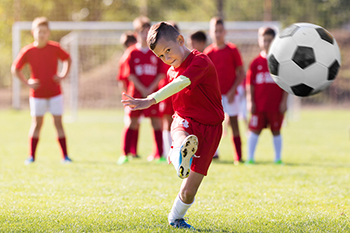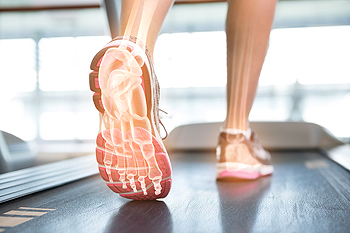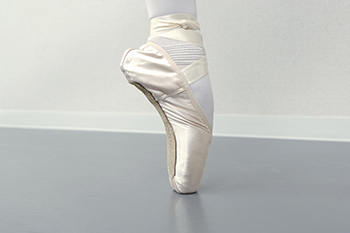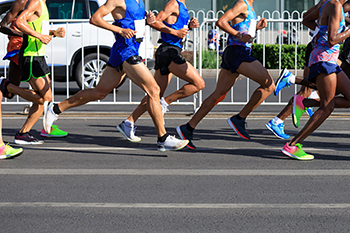October 2022
Causes and Treatment of Sever’s Disease

One of the most common heel pain complaints from children is from Sever’s disease. Fortunately, this ailment has a relatively short life span and does not result in long-term damage. Sever’s disease generally affects physically active children between the ages of 8 and 14. It is common among children who do a lot of running and jumping during sports activities. Also known as calcaneal apophysitis, Sever’s disease occurs when the calf's bones grow faster than the Achilles tendon that attaches them to the heel. This disparity causes the tendon to become tight and results in soreness in the heel. When the disparity in the growth plate is resolved, the pain goes away. Symptoms include limping, pain or tenderness in the heel while active, and swelling in the heel area. The first, and most important, way to treat Sever’s disease is to cease the activity causing it to occur. If after a few weeks, pain and swelling are still a problem, it is a good idea to seek the counsel of a podiatrist for further examination and other treatment options that may be necessary.
Sever's disease often occurs in children and teens. If your child is experiencing foot or ankle pain, see one of our podiatrists from Bazzi Podiatry. Our doctors can treat your child’s foot and ankle needs.
Sever’s Disease
Sever’s disease is also known as calcaneal apophysitis, which is a medical condition that causes heel pain I none or both feet. The disease is known to affect children between the ages of 8 and 14.
Sever’s disease occurs when part of the child’s heel known as the growth plate (calcaneal epiphysis) is attached to the Achilles tendon. This area can suffer injury when the muscles and tendons of the growing foot do not keep pace with bone growth. Therefore, the constant pain which one experiences at the back of the heel will make the child unable to put any weight on the heel. The child is then forced to walk on their toes.
Symptoms
Acute pain – Pain associated with Sever’s disease is usually felt in the heel when the child engages in physical activity such as walking, jumping and or running.
Highly active – Children who are very active are among the most susceptible in experiencing Sever’s disease, because of the stress and tension placed on their feet.
If you have any questions, please feel free to contact one of our offices located in Detroit, West Detroit, Northwest Detroit, Sterling Heights, Hamtramck, Dearborn Heights, Madison Heights, Redford, and Livonia, MI . We offer the newest diagnostic and treatment technologies for all your foot and ankle injuries.
All About Foot Mechanics

The design of the many different bones, muscles, and ligaments in the feet is masterful and enables the feet to move to perform their different functions. There are 26 bones in each foot, which includes the phalanges in the toes, the metatarsals in the middle of the foot, and the calcaneus bone at the heel. There are also approximately 30 joints in the feet and 100 different ligaments. The feet contain a group of intrinsic muscles and ligaments. These are primarily located across the bottoms, or soles, of the feet. This group is contrasted with the extrinsic muscles and ligaments that are found in the lower leg and essentially curve around the ankle. This then attaches to the foot. If you want to learn more about the biomechanics of the foot and how this critical body part functions, contact a podiatrist today.
If you have any concerns about your feet, contact one of our podiatrists from Bazzi Podiatry. Our doctors can provide the care you need to keep you pain-free and on your feet.
Biomechanics in Podiatry
Podiatric biomechanics is a particular sector of specialty podiatry with licensed practitioners who are trained to diagnose and treat conditions affecting the foot, ankle and lower leg. Biomechanics deals with the forces that act against the body, causing an interference with the biological structures. It focuses on the movement of the ankle, the foot and the forces that interact with them.
A History of Biomechanics
- Biomechanics dates back to the BC era in Egypt where evidence of professional foot care has been recorded.
- In 1974, biomechanics gained a higher profile from the studies of Merton Root, who claimed that by changing or controlling the forces between the ankle and the foot, corrections or conditions could be implemented to gain strength and coordination in the area.
Modern technological improvements are based on past theories and therapeutic processes that provide a better understanding of podiatric concepts for biomechanics. Computers can provide accurate information about the forces and patterns of the feet and lower legs.
Understanding biomechanics of the feet can help improve and eliminate pain, stopping further stress to the foot.
If you have any questions please feel free to contact one of our offices located in Detroit, West Detroit, Northwest Detroit, Sterling Heights, Hamtramck, Dearborn Heights, Madison Heights, Redford, and Livonia, MI . We offer the newest diagnostic and treatment technologies for all your foot and ankle needs.
What Is Os Trigonum Syndrome?

Os trigonum syndrome refers to pain in the back of the ankle bone (the talus), usually the result of overuse or trauma. The os trigonum is an extra bone that is connected to the talus by a band of fibrous tissue. It is congenital (present at birth) and In most cases, the extra bone fuses with the talus, causing no problems. Os trigonum syndrome is generally kicked off by an injury, such as a sprained ankle. It also may be caused by excessive downward pointing of the foot, and is common to dancers and soccer players. In such cases, the os trigonum gets caught between the ankle and heel bones, in a nutcracker-like effect, which induces pain. This can tear the fibrous tissue surrounding it and result in inflammation. Rest, ice and elevation are the first level of treatment, but injections of cortisone and taking anti-inflammatory medication may also be needed. The pain from os trigonum syndrome is often confused with Achilles tendonitis. Please see a podiatrist for a proper diagnosis and treatment plan.
Ankle pain can have many different causes and the pain may potentially be serious. If you have ankle pain, consult with one of our podiatrists from Bazzi Podiatry. Our doctors will assess your condition and provide you with quality foot and ankle treatment.
Ankle pain is any condition that causes pain in the ankle. Due to the fact that the ankle consists of tendons, muscles, bones, and ligaments, ankle pain can come from a number of different conditions.
Causes
The most common causes of ankle pain include:
- Types of arthritis (rheumatoid, osteoarthritis, and gout)
- Ankle sprains
- Broken ankles
- Achilles tendinitis
- Achilles tendon rupture
- Stress fractures
- Tarsal tunnel syndrome
- Plantar fasciitis
Symptoms
Symptoms of ankle injury vary based upon the condition. Pain may include general pain and discomfort, swelling, aching, redness, bruising, burning or stabbing sensations, and/or loss of sensation.
Diagnosis
Due to the wide variety of potential causes of ankle pain, podiatrists will utilize a number of different methods to properly diagnose ankle pain. This can include asking for personal and family medical histories and of any recent injuries. Further diagnosis may include sensation tests, a physical examination, and potentially x-rays or other imaging tests.
Treatment
Just as the range of causes varies widely, so do treatments. Some more common treatments are rest, ice packs, keeping pressure off the foot, orthotics and braces, medication for inflammation and pain, and surgery.
If you have any questions, please feel free to contact one of our offices located in Detroit, West Detroit, Northwest Detroit, Sterling Heights, Hamtramck, Dearborn Heights, Madison Heights, Redford, and Livonia, MI . We offer the newest diagnostic and treatment technologies for all your foot care needs.
Do Your Child's Feet Hurt?
Ways to Avoid Running Injuries

Many beginning runners make mistakes that can cause injuries. Here are a few tips to prevent that from happening. Start with getting running shoes that are right for your feet, which includes evaluating your running style and foot type. It is recommended to replace shoes after about 350 miles, and to alternate with an extra pair when you are halfway through the lifespan of your first pair of shoes. Second, try to avoid doing too much, too soon. Experts agree that the easiest way to get injured is by running too far, for too long, too fast, and too often. It is advised to increase mileage by a maximum of 10 percent a week. It is also recommended to combine walking and running, at first, as well as taking at least one day off between runs. One of the most common causes of injury in beginners is overstriding, which consists of landing heel first with your foot ahead of the body’s center of gravity. Instead, try landing midsole, with the body’s weight directly over the foot. If you need further guidance about gait and foot type, or are having problems with your feet and ankles after running, please consult with a podiatrist.
All runners should take extra precaution when trying to avoid injury. If you have any concerns about your feet, contact one of our podiatrists of Bazzi Podiatry. Our doctors will treat your foot and ankle needs.
How to Prevent Running Injuries
There are a lot of mistakes a runner can make prior to a workout that can induce injury. A lot of athletes tend to overstretch before running, instead of saving those workouts for a post-run routine. Deep lunges and hand-to-toe hamstring pulls should be performed after a workout instead of during a warmup. Another common mistake is jumping into an intense routine before your body is physically prepared for it. You should try to ease your way into long-distance running instead of forcing yourself to rush into it.
More Tips for Preventing Injury
- Incorporate Strength Training into Workouts - This will help improve the body’s overall athleticism
- Improve and Maintain Your Flexibility – Stretching everyday will help improve overall performance
- “Warm Up” Before Running and “Cool Down” Afterward – A warm up of 5-10 minutes helps get rid of lactic acid in the muscles and prevents delayed muscle soreness
- Cross-Training is Crucial
- Wear Proper Running Shoes
- Have a Formal Gait Analysis – Poor biomechanics can easily cause injury
If you have any questions, please feel free to contact one of our offices located in Detroit, West Detroit, Northwest Detroit, Sterling Heights, Hamtramck, Dearborn Heights, Madison Heights, Redford, and Livonia, MI . We offer the newest diagnostic and treatment technologies for all your foot care needs.





